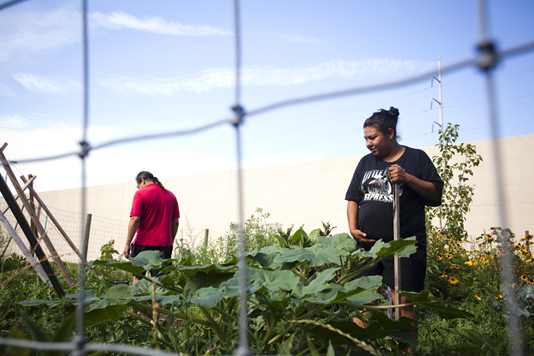This spotlight is a feature in a series of the USDA Community Food Project Competitive Grant Program (CFP). Grantees are doing some of the most innovative and collaborative projects to change local and regional food systems. WhyHunger’s www. — also funded by a CFP grant — has recently begun to profile these organizations through dynamic stories and pictures, to give a real flavor of what the projects look like and how they’re accomplishing their goals. We’ll be sharing these profiles on the blog in the coming months — and you can check out more anytime on the www..
* * *
It’s Women’s History Month, and who better to celebrate than The Women’s Environmental Institute (WEI). WEI is an environmental research, renewal and retreat center designed to create and share knowledge about environmental issues and policies relevant to women, children and identified communities especially affected by environmental injustices; to promote agricultural justice, organic and sustainable agriculture and ecological awareness; and to support activism that influences public policy and promotes social change. Their Community Food Project had two main goals:
- To understand the food assets and barriers in these two communities, and the particular food needs and perceptions of the population (differentiated by age and ethnicity); and
- To design a nuanced plan, based on community research and participation, for improving the long-term food security in the two communities.

Vince Vang Lee Xiong and his mother stoop to pick shiny, metallic beetles off the leaves of broccoli plants. They toss the pests into a pickle bucket with two inches of water on the bottom. It’s slow, tedious work, but Vince’s mother and his father, who also works this farm, have been growing food this way since they could walk. Only there were no pests in their homeland of Laos, too many predatory insects to take care of rapacious little beetles.
Vince and his family are Hmong. They arrived to Minneapolis in the late 1970s, a decade that saw tens of thousands of Hmong people flee from the regime of communist movement Pathet Lao. More Hmong now live in the Twin Cities than anywhere else in the world.
Vince and his family live in Plymouth City, a middle-class suburb west of Minneapolis. It’s over an hour drive from the farm, and Vince and his parents come to work six days a week for eight to fourteen hours a day in the summer. They drive the family’s gold Toyota mini-van through the congested interstates of the Twin Cities then northeast to the Maine Food Association’s farmland at the Wilder Forest, one of the most bucolic settings in all of America, a place where small-scale, bio-diverse farm traditions live on.
Read the rest of the profile on the Food Security Learning Center…
* * *
Since 2004, WhyHunger has featured USDA Community Food Project (CFP) grantees on a database as part of our Food Security Learning Center. The Community Food Projects Competitive Grant Program was started in 1996 to fight hunger and promote self-sufficiency in low-income communities. Community Food Projects are designed to increase food security by bringing together stakeholders from across the food system to assess strengths, establish links and relationships, and create solutions that work for the whole community.


